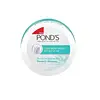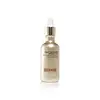What's inside
What's inside
 Key Ingredients
Key Ingredients

 Benefits
Benefits

 Concerns
Concerns

 Ingredients Side-by-side
Ingredients Side-by-side

Water
Skin ConditioningDimethicone
EmollientGlycerin
HumectantButylene Glycol
HumectantAmmonium Acryloyldimethyltaurate/Vp Copolymer
Niacinamide
SmoothingLinoleamidopropyl Pg-Dimonium Chloride Phosphate
Phenoxyethanol
PreservativeAmmonium Acryloyldimethyltaurate/Beheneth-25 Methacrylate Crosspolymer
Emulsion StabilisingParfum
MaskingSodium PCA
HumectantDisodium EDTA
Stearic Acid
CleansingCaprylic/Capric Triglyceride
MaskingTocopheryl Acetate
AntioxidantTriethanolamine
BufferingBHT
AntioxidantIodopropynyl Butylcarbamate
PreservativeSodium Hyaluronate Crosspolymer
HumectantSodium Hyaluronate
HumectantSodium Acetylated Hyaluronate
HumectantHydrolyzed Hyaluronic Acid
HumectantPentylene Glycol
Skin ConditioningEthylhexylglycerin
Skin ConditioningCitral
PerfumingCitronellol
PerfumingGeraniol
PerfumingHexyl Cinnamal
PerfumingLimonene
PerfumingLinalool
PerfumingCI 42090
Cosmetic ColorantWater, Dimethicone, Glycerin, Butylene Glycol, Ammonium Acryloyldimethyltaurate/Vp Copolymer, Niacinamide, Linoleamidopropyl Pg-Dimonium Chloride Phosphate, Phenoxyethanol, Ammonium Acryloyldimethyltaurate/Beheneth-25 Methacrylate Crosspolymer, Parfum, Sodium PCA, Disodium EDTA, Stearic Acid, Caprylic/Capric Triglyceride, Tocopheryl Acetate, Triethanolamine, BHT, Iodopropynyl Butylcarbamate, Sodium Hyaluronate Crosspolymer, Sodium Hyaluronate, Sodium Acetylated Hyaluronate, Hydrolyzed Hyaluronic Acid, Pentylene Glycol, Ethylhexylglycerin, Citral, Citronellol, Geraniol, Hexyl Cinnamal, Limonene, Linalool, CI 42090
Water
Skin ConditioningCaprylic/Capric Triglyceride
MaskingButylene Glycol
HumectantGlycerin
HumectantIsododecane
EmollientDimethicone
EmollientIsostearyl Isostearate
EmollientNiacinamide
SmoothingPolymethylsilsesquioxane
Neopentyl Glycol Diheptanoate
EmollientPolyglyceryl-6 Polyhydroxystearate
EmulsifyingPolyglyceryl-6 Polyricinoleate
EmulsifyingMagnesium Sulfate
Sodium Chloride
MaskingParachlorella Beijerinckii Exopolysaccharides
Skin ProtectingPhloretin
AntioxidantFucus Spiralis Extract
EmollientTetraselmis Chui Extract
EmollientSpiraea Ulmaria Extract
AstringentHydrolyzed Algin
Sorbitan Oleate Decylglucoside Crosspolymer
CleansingDisteardimonium Hectorite
StabilisingPolyglycerin-6
HumectantXanthan Gum
EmulsifyingTriethyl Citrate
MaskingLavandula Angustifolia Extract
Skin ConditioningEucalyptus Globulus Leaf Extract
PerfumingBergamot/Grapefruit/Orange/Tangerine Fruit Ferment Extract
AntioxidantMica
Cosmetic ColorantCitrus Limon Fruit Extract
MaskingEthylhexylglycerin
Skin ConditioningTriethoxycaprylylsilane
Phenoxyethanol
PreservativeCI 77891
Cosmetic ColorantWater, Caprylic/Capric Triglyceride, Butylene Glycol, Glycerin, Isododecane, Dimethicone, Isostearyl Isostearate, Niacinamide, Polymethylsilsesquioxane, Neopentyl Glycol Diheptanoate, Polyglyceryl-6 Polyhydroxystearate, Polyglyceryl-6 Polyricinoleate, Magnesium Sulfate, Sodium Chloride, Parachlorella Beijerinckii Exopolysaccharides, Phloretin, Fucus Spiralis Extract, Tetraselmis Chui Extract, Spiraea Ulmaria Extract, Hydrolyzed Algin, Sorbitan Oleate Decylglucoside Crosspolymer, Disteardimonium Hectorite, Polyglycerin-6, Xanthan Gum, Triethyl Citrate, Lavandula Angustifolia Extract, Eucalyptus Globulus Leaf Extract, Bergamot/Grapefruit/Orange/Tangerine Fruit Ferment Extract, Mica, Citrus Limon Fruit Extract, Ethylhexylglycerin, Triethoxycaprylylsilane, Phenoxyethanol, CI 77891
 Reviews
Reviews

Ingredients Explained
These ingredients are found in both products.
Ingredients higher up in an ingredient list are typically present in a larger amount.
Butylene Glycol (or BG) is used within cosmetic products for a few different reasons:
Overall, Butylene Glycol is a safe and well-rounded ingredient that works well with other ingredients.
Though this ingredient works well with most skin types, some people with sensitive skin may experience a reaction such as allergic rashes, closed comedones, or itchiness.
Learn more about Butylene GlycolThis ingredient is an emollient, solvent, and texture enhancer. It is considered a skin-softener by helping the skin prevent moisture loss.
It helps thicken a product's formula and makes it easier to spread by dissolving clumping compounds.
Caprylic Triglyceride is made by combining glycerin with coconut oil, forming a clear liquid.
While there is an assumption Caprylic Triglyceride can clog pores due to it being derived from coconut oil, there is no research supporting this.
Learn more about Caprylic/Capric TriglycerideDimethicone is a type of synthetic silicone created from natural materials such as quartz.
What it does:
Dimethicone comes in different viscosities:
Depending on the viscosity, dimethicone has different properties.
Ingredients lists don't always show which type is used, so we recommend reaching out to the brand if you have questions about the viscosity.
This ingredient is unlikely to cause irritation because it does not get absorbed into skin. However, people with silicone allergies should be careful about using this ingredient.
Note: Dimethicone may contribute to pilling. This is because it is not oil or water soluble, so pilling may occur when layered with products. When mixed with heavy oils in a formula, the outcome is also quite greasy.
Learn more about DimethiconeEthylhexylglycerin (we can't pronounce this either) is commonly used as a preservative and skin softener. It is derived from glyceryl.
You might see Ethylhexylglycerin often paired with other preservatives such as phenoxyethanol. Ethylhexylglycerin has been found to increase the effectiveness of these other preservatives.
Glycerin is already naturally found in your skin. It helps moisturize and protect your skin.
A study from 2016 found glycerin to be more effective as a humectant than AHAs and hyaluronic acid.
As a humectant, it helps the skin stay hydrated by pulling moisture to your skin. The low molecular weight of glycerin allows it to pull moisture into the deeper layers of your skin.
Hydrated skin improves your skin barrier; Your skin barrier helps protect against irritants and bacteria.
Glycerin has also been found to have antimicrobial and antiviral properties. Due to these properties, glycerin is often used in wound and burn treatments.
In cosmetics, glycerin is usually derived from plants such as soybean or palm. However, it can also be sourced from animals, such as tallow or animal fat.
This ingredient is organic, colorless, odorless, and non-toxic.
Glycerin is the name for this ingredient in American English. British English uses Glycerol/Glycerine.
Learn more about GlycerinNiacinamide is a multitasking form of vitamin B3 that strengthens the skin barrier, reduces pores and dark spots, regulates oil, and improves signs of aging.
And the best part? It's gentle and well-tolerated by most skin types, including sensitive and reactive skin.
You might have heard of "niacin flush", or the reddening of skin that causes itchiness. Niacinamide has not been found to cause this.
In very rare cases, some individuals may not be able to tolerate niacinamide at all or experience an allergic reaction to it.
If you are experiencing flaking, irritation, and dryness with this ingredient, be sure to double check all your products as this ingredient can be found in all categories of skincare.
When incorporating niacinamide into your routine, look out for concentration amounts. Typically, 5% niacinamide provides benefits such as fading dark spots. However, if you have sensitive skin, it is better to begin with a smaller concentration.
When you apply niacinamide to your skin, your body converts it into nicotinamide adenine dinucleotide (NAD). NAD is an essential coenzyme that is already found in your cells as "fuel" and powers countless biological processes.
In your skin, NAD helps repair cell damage, produce new healthy cells, support collagen production, strengthen the skin barrier, and fight environmental stressors (like UV and pollution).
Our natural NAD levels start to decline with age, leading to slower skin repair, visible aging, and a weaker skin barrier. By providing your skin niacinamide, you're recharging your skin's NAD levels. This leads to stronger, healthier, and younger looking skin.
Another name for vitamin B3 is nicotinamide. This vitamin is water-soluble and our bodies don't store it. We obtain Vitamin B3 from either food or skincare. Meat, fish, wheat, yeast, and leafy greens contain vitamin B3.
The type of niacinamide used in skincare is synthetically created.
Learn more about NiacinamidePhenoxyethanol is a preservative that has germicide, antimicrobial, and aromatic properties. Studies show that phenoxyethanol can prevent microbial growth. By itself, it has a scent that is similar to that of a rose.
It's often used in formulations along with Caprylyl Glycol to preserve the shelf life of products.
Water. It's the most common cosmetic ingredient of all. You'll usually see it at the top of ingredient lists, meaning that it makes up the largest part of the product.
So why is it so popular? Water most often acts as a solvent - this means that it helps dissolve other ingredients into the formulation.
You'll also recognize water as that liquid we all need to stay alive. If you see this, drink a glass of water. Stay hydrated!
Learn more about Water